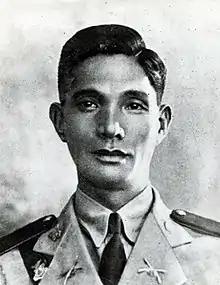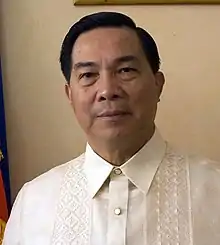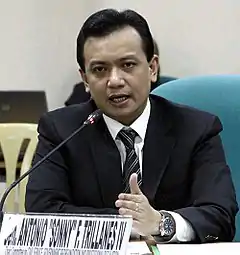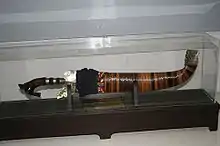Philippine Military Academy
The Philippine Military Academy (PMA; Filipino: Akademiyang Militar ng Pilipinas; Spanish: Academia Militar de Filipinas) is the premier military academy for Filipinos aspiring for a commission as a military officer of the Armed Forces of the Philippines (AFP).[2] It was established on December 21, 1936 by the virtue of National Defense Act of 1935. It is patterned after the United States Military Academy.[3] The Academy is located in the city of Baguio.[4] It is the training school for future officers of the AFP.[5][6]
Akademiyang Militar ng Pilipinas | |
.svg.png.webp) | |
| Latin: Philippine Academiae Militaris | |
Former names | Academia Militar de Malolos (1898–1905) Officer's School, Philippine Constabulary (1905–1926) Philippine Constabulary Academy (1926–1935) |
|---|---|
| Motto | Courage Integrity Loyalty |
| Type | Service academy |
| Established | October 25, 1898 |
| Superintendent | LtGen. Ferdinand M. Cartujano, PAF [1] |
| Commandant of Cadets | BGen. Romeo Brawner, Jr. |
| Address | Fort General Gregorio del Pilar , , |
| Campus | Fort del Pilar (373 hectares) |
| Alma Mater song | "PMA, Oh Hail to Thee." |
| Colours | Gray |
| Nickname | PMA Cavaliers- "Mistah" or "Bok" |
| Affiliations | NDCP, AFP |
| Website | www |
 | |
The academy traces its roots to 1898, when General Antonio Luna led the establishment of the Academia Militar in the Philippines. From then on, the academy serves as a national historical landmark for historic contribution and its “long and unending line of quality military education.”[7] The campus is a popular tourist destination in Baguio City.[8]
Cadet Candidates for admission must undergo and pass series of testing (Written, Physical, Medical and Neuro-Psychiatric); around 400 men and women enter the Academy each June.[9][10] Students are officers-in-training and referred to as "cadets" or collectively as the "Cadet Corps Armed Forces of the Philippines" (CCAFP).[11] Tuition and monthly allowances are fully funded by the government in exchange for an active duty service obligation upon graduation.
The academic program grants a Bachelor of Science in National Security Management with a curriculum that maintains a high level standard of cadet's performance in academics, military tactics and sports & physical fitness. Cadets are required to conform with the Honor Code which states that "We, the cadets, do not lie, cheat, steal, nor tolerate among us those who do." PMA bases cadet's development in four aspects: character, academics, military and physical.[12] Graduates are commissioned as second lieutenants in the Philippine Army and Philippine Air Force and as ensigns in the Philippine Navy.
Despite the limited baccalaureate offered, the academy consistently places in the top 100 Universities and Colleges in Philippines for its quality education and management.[13] PMA is ISO 9001:2015 certified.[14]
History
An Officer's School of the Philippine Constabulary was established on February 17, 1905 within the walls of Intramuros in Manila.[15] This school was relocated to Baguio on September 1, 1908, at Camp Henry Allen where it would stay for many years to come.
On a Monday, October 23, 1916, immediately after assuming his position as senator representing Mindanao and Sulu, Senator Hadji Butu Abdul Baqui sponsored his first bill, Senate Bill No. 9 creating a law establishing a military academy and requiring military education in colleges and universities. On the same day, he also sponsored Senate Bill No. 10 creating a law to establish a naval academy. (From Senate Diaries of the 4th Philippine Legislature, Volume 1, page 32, October 1916, original copy (in Spanish) at Adams Building, U.S. Library of Congress, from research work of Dr. Abraham T. Rasul, Jr., Washington DC). On February 9, 1917, US President Woodrow Wilson, in an article written in the Buffalo Enquirer mentioned "military or naval training will be a good thing for the young men of the country" and congratulated Senator Hadji Butu "for being the first among those in the upper house to introduce the measures for their establishment".
After the Philippine Legislature passed Act No. 3496 on September 8, 1926, the school was renamed the Philippine Constabulary Academy and courses were lengthened from nine months to three years. Just as the PC started with American and Filipino officers, the school had American and Filipino officer cadets in its student body.
When the National Defense Act was approved on December 21, 1935, the Philippine Constabulary Academy was renamed Philippine Military Academy and was permitted to grant its graduates Bachelor of Science degrees after completion of their four-year curriculum.[16] PMA was modeled after the United States Military Academy with officers from the Philippine Scouts and regular United States Army as instructors and members of the general staff.[17][18] PMA Class of 1940, with 79 graduates, was the pioneer batch to complete four years of training. Quirico Evangelista and Reynaldo Mendoza of Class '40 composed the PMA alma mater song, "PMA, Oh Hail to Thee."

With the outbreak of the Second World War, training was disrupted at the PMA with Classes 1942 and 1943 being graduated prematurely and assigned to combat units in Bataan and other parts of the country. Many of these young officers perished in the war.
After the war, the Academy was reopened on May 5, 1947, at Camp Henry T. Allen in Baguio. But due to its increasing need for larger grounds, it was soon moved to its present location at Fort General Gregorio H. del Pilar, Loakan, some ten kilometers from downtown Baguio. The main building, Melchor Hall, was completed in 1949 under the supervision of military engineer Lt. Pacifico C. Cabrera, a decorated WWII hero, who later as a full colonel, became Chief of Engineers of the AFP. During the 1960s, as a need for more well-rounded individuals was found to be desirable, and socio-humanistic courses were added to the school's curriculum.
1993 proved a momentous year for the PMA as its first female cadets were admitted and specialization based on branch-of-service was introduced into the curriculum. The first female cadets graduated from the Academy in 1997.
In 1998, a proclamation by the President of the Philippines, while acknowledging the academy's traditional roots lay with the 1905 founding of the Philippine Constabulary school, changed the official celebration day of the academy to October 25, in honour of the Academia Militar which was established on October 25, 1898 in Malolos, Bulacan.[15] Other sources have since acknowledged this change.[19][20] The Academia Militar was opened during the establishment of the insurgent First Philippine Republic. It was closed on January 20, 1899, before the Philippine–American War and thus was the first ever all-Filipino military academy to be established.[21]
Curriculum
Academic Program
Headed by the Dean of Academics, the Academic Program has both military and civilian male and female instructors. It has the following seven departments:
- Department of Managerial Sciences
- Department of Mathematics
- Department of Humanities
- Department of Physical Sciences
- Department of Engineering Sciences
- Department of Social Sciences
- Department of Information and Computing Sciences[22]
On June 1, 2019, the PMA upgraded its academic curriculum; every cadet now focuses on national security management in response to growing national security threat. Upon completing and graduating from 4 year program, cadets will earn the degree of BS National Security Management and will be commissioned as 2nd Lieutenant or Ensign in the tri-services of the AFP.[23]
Military Program
This program is headed by the Commandant of Cadets and is responsible for the professional military training, character development, leadership, and physical training of the cadets. The mission of the Tactics Group is likewise carried out by the tactical officers who are responsible for the different companies of the Cadet Corps. This group is made up of the following departments:
- Department of Leadership Development
- Department of Physical Education
- Department of Ground Warfare
- Department of Air Warfare'
- Department of Naval Warfare
Cadet life
Four classes
Unlike other colleges and universities, cadets are not referred to as freshmen, sophomores, juniors, or seniors. They are classified as fourth class, third class, second class, and first class cadets.
- Fourthclass Cadets are the first year students. In the Academy, they are traditionally called "plebes" and are the equivalent of the college freshmen in civilian universities. The first day of plebehood starts with the Reception Ceremonies on June 1 of each year. Then, they undergo an eight week summer training or "beast barracks" during which time they are indoctrinated with the military and cadet systems of training. During this period, the plebes form the New Cadet Battalion and their training is handled by the tactical officers and upper-class cadets forming the "Plebe Detail." After the beast barracks, the plebes are formally accepted into the ranks of the Cadet Corps in another ceremony called Incorporation which is held during the last week of May.
- Thirdclass Cadets are sophomores in civilian universities, and called the "yearlings" in the Academy, starts upon completion of fourthclass year. During this period, the yearling adjusts to life as an upperclass cadet. Although they are the least ranking of the upperclass cadets, they are now entitled to the privileges of being upperclass cadets. One of their responsibilities is being a "buddy" to a plebe. As buddies, they set the examples of how a cadet should behave and they are responsible for ensuring that the plebes conform with the standards of cadetship.
- Secondclass Cadets are also called the "cows". The secondclass year marks the point at which the cadet starts to specialize according to the branch of service he or she has elected to join. Thus, the secondclass cadets no longer take the same subjects as each of his or her classmates but they now take different subjects depending on their branches of service and fields of specialization. Within the cadet chain of command, the secondclass cadets now act as squad leaders. Moreover, in the absence of the firstclass cadets, they take over the responsibility of running the Cadet Corps.
- Firstclass Cadets, also known as "immaculates", are the ruling class and as such they occupy the major positions of responsibility in the cadet chain of command. They are designated the chairmen and cadet-in-charge of the various committees, clubs and corps squads. They also enjoy certain privileges peculiar only to the "immaculates". Their academics are also more specialized as they now embark on the final year of their training for future officership in the Armed Forces of the Philippines.
Organization
The Cadet Corps is organized into a brigade. The highest ranking cadet, the Brigade Commander, is traditionally known as the First Captain or "Baron".[25] The brigade is organized into four battalions. Within each battalion there are two companies. Companies are lettered A through H (Alfa to Hawk). First class cadets hold key leadership positions within the brigade from the First Captain down to platoon leaders within the companies. First class cadets hold the rank of cadet captain and cadet lieutenant. Second class cadets hold the rank of cadet sergeant and serve as squadleaders, third class cadets hold the rank of cadet corporal, and fourth class cadets as cadet private.[26]
Honor Code and System
The Philippine Military Academy is governed by an honor code, and it binds the cadets to the following principle — “We, the cadets, do not lie, cheat, steal, nor tolerate among us those who do.”. Cheating, lying, and stealing are major honor code violations. Cadets who will be charged for violating the honor code are subjected to series of trials conducted by Cadets from Honor Committee. When a cadet is found guilty for violating the honor code, he/she will be banned from cadetship. One of the most sensationalized cases was during 2014; the lying case of ex-cadet Aldrin Jeff Cudia.[27]
Admission Requirements
- Natural Born Filipino Citizen
- Physically fit and of good moral character
- Single and has never been married
- Must pass the PMA Entrance Examination
- No Administrative / Criminal Case
- At least High School Graduate with 85% GPA or must graduate not later than June of the year following the date of examination taken for Grade 12 students (K-12)
- Height Requirement for both Male and Female is 5 feet (not to exceed 6’4″ for both)
- At least 17 years old but not a day older than a 22 years on 1 June of the year following the date of examination taken
Controversies
Death of Darwin Dormitorio
A 20-year-old Cadet 4th class Darwin Dormitorio died as a result of hazing inside the campus at the hands of his fellow cadets. Following the incident, the police have named seven persons of interest for his death.[28]
Hazing videos
On October 23, 2019, two videos, dated 2017 and 2018, of torture by the cadets were uploaded on social media. The 2018 video shows a cadet being punched and kicked by a fellow cadet. Another cadet wearing earphones is seen in the background of the video. In the video, two cadets were doing squats; when one of them collapses, he is kicked as punishment by an upperclassman. The attack stops when someone opens the door to inspect the room. The 2017 video shows four upperclassmen with two plebes. An upperclassman is seen using his helmet to repeatedly hit one of the plebe's hands and the other's back. While the upperclassman attacks the plebes, the other cadets in the background were seen watching and laughing, actively bystanding and allowing the torture to continue.[29][30][31]
Of the six upper-class cadets seen attacking the plebes in the video, five were transferred to the PMA holding center while the academy investigated the incident; on the other hand, the sixth cadet was discharged from the academy due to an "Honor Code" violation.[29][30]
Notable alumni
- Notable people




.jpg.webp)


.jpg.webp)

.jpg.webp)


.jpg.webp)
.jpg.webp)
.jpg.webp)

Gallery
 Detail of parapet of Melchor Hall, PMA
Detail of parapet of Melchor Hall, PMA Graduating PMA cadets at the PMA Alumni Homecoming, 2012
Graduating PMA cadets at the PMA Alumni Homecoming, 2012 Barong dagger of Mujib Susukan, part of war booty displayed at the Philippine Military Academy Museum
Barong dagger of Mujib Susukan, part of war booty displayed at the Philippine Military Academy Museum Flowers on the grounds of the PMA campus
Flowers on the grounds of the PMA campus Shaku, PMA's Landmark
Shaku, PMA's Landmark
See also
References
- Inquirer, Philippine Daily (November 20, 2020). "New superintendent for PMA named". INQUIRER.net.
- archives/23957-Over-11,000-men,-women-apply-for-PMA-exam.html "Over 11,000 men, women apply for PMA exam - ZamboTimes" Check
|url=value (help). Retrieved 15 March 2015. - "Commonwealth Act No. 1:PHILIPPINE LAWS, STATUTES and CODES : CHAN ROBLES VIRTUAL LAW LIBRARY". Retrieved 15 March 2015.
- [http:// www.pma. ph/?pageid= AbouttheAcademy About the Philippine Military Academy]
- "Armed Forces of the Philippines".
- 24718-gov-sahali-lauds-pma-for-holding-entrance-examinations-in-tawi-tawi "The Manila Times Online - Trusted Since 1898" Check
|url=value (help). Retrieved 15 March 2015. - Quitasol, Kimberlie (May 21, 2019). "PMA declared national historical landmark". INQUIRER.net.
- "PMA is still the best tourist spot to go in Baguio City - Review of Philippine Military Academy, Baguio, Philippines". Tripadvisor.
- Dumlao, Artemio. "400 plebes to enter PMA". Philstar.com.
- "400 young Filipinos compose PMA Class of 2022". pia.gov.ph.
- "CCAFP" – via The Free Dictionary.
- https://www.pma.ph/
- "2020 Top 200 Universities, Colleges in the Philippines".
- "ID No. 9105074148: Philippine Military Academy - Certipedia". www.certipedia.com.
- "Proclamation No. 35, s. 1998". Official Gazette of the Republic of the Philippines.
- "Commonwealth Act No. 1 : The National Defense Act". Chan Robles Law Library. December 21, 1935.
- Jose, Ricardo Trota (1992). The Philippine Army, 1935–1942. Ateneo de Manila University Press. p. 36. ISBN 978-971-550-081-4. Retrieved 28 February 2012.
- McCoy, Alfred W. (1999). Closer Than Brothers: Manhood at the Philippine Military Academy. Yale University Press. p. 31. ISBN 9780300077650. Retrieved 11 September 2012.
- "About the Academy". Official website of the Philippine Military Academy.
- "Philippine Military Academy 115th Anniversary". Tempo.
- "Today in Philippine History, October 25, 1898, the Academia Militar was established in Malolos, Bulacan by General Emilio Aguinaldo". kahimyang.com.
- https://www.pma.ph/acadProgram.php
- Guieb, Marilou (May 27, 2019). "PMA training now focuses on national security management | Marilou Guieb". BusinessMirror.
- https://www.pma.ph/milProgram.php
- Cimatu, Frank. "7 things you need to know about PMA valedictorians, barons". Rappler.
- https://www.youtube.com/watch?v=v0yAYUHD3uY
- "Did PMA cadet Cudia lie? Document shows details". Rappler.
- "7th suspect in PMA cadet's slay identified". ABS-CBN News. Retrieved September 29, 2019.
- "Saksi: 5 kadete na sangkot sa na-videohang pananakit ng ilang plebo ng PMA, under strict confinement". GMA News on YouTube.
- "WATCH: Hazing inside the PMA barracks". Rappler. Retrieved October 24, 2019.
- "1 PMA cadet discharged, 5 others detained over newly-surfaced hazing video". CNN Philippines.
Senate Diaries, 4th Philippine Legislature,Volume 1, page 32, October 23, 1916 (original in Spanish) Original copy located in Adams Building, US Library of Congress
External links
| Wikimedia Commons has media related to Philippine Military Academy. |